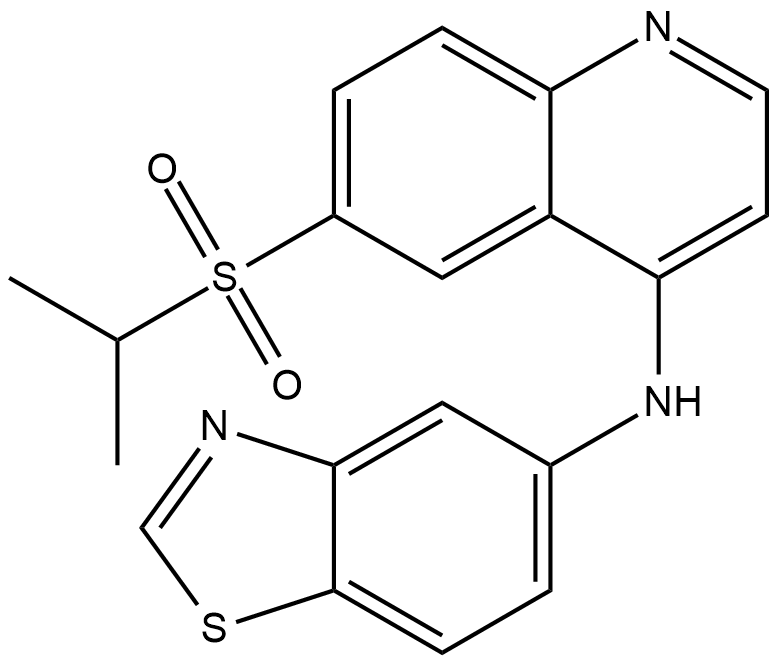GSK-872 |
| Catalog No.GC19175 |
GSK-872 is a RIPK3 inhibitor.
Products are for research use only. Not for human use. We do not sell to patients.

Cas No.: 1346546-69-7
Sample solution is provided at 25 µL, 10mM.
GSK-872 is a RIPK3 inhibitor. GSK-872 decreases the RIPK3-mediated necroptosis and subsequent cytoplasmic translocation and expression of HMGB1, as well as ameliorates brain edema and neurological deficits in early brain injury[5]. GSK-872 bound RIP3 kinase domain with high affinity (IC50 = 1.8 nM) and inhibited kinase activity (IC50 = 1.3 nM) [1]. GSK-872 prevented virus-induced necrosis, a pathway dependent on DAI-RIP3 complex formation,GSK-872 blocked TLR3-induced necrosis induced in fibroblasts by poly(I:C) in the presence of Z-VAD-fmk, Both virus- and TLR3-induced necrosis proceed independently of RIP1 kinase inhibition by Nec-1 but sensitive to inhibition by GSK-872 [2,3,4]. Pharmacological inhibitor GSK-872 enhanced insulin signaling in vitro and in vivo, which contributing to improve insulin sensitivity[9].
When evaluated in cell culture using human HT-29 cells, GSK-872 bind the kinase domain and inhibit kinase activity with high specificity, targeting a broader range of pronecrotic stimuli [1]. RIP3i compounds GSK-872 blocked TNF-induced necroptosis in a concentration-dependent manner . In cell-based assays, there was a 100- to 1,000-fold shift in the IC50 compared to the cell-free biochemical assays. GSK-872 blocked necroptosis in primary human neutrophils isolated from whole blood,and blocked necroptosis in mouse cells. Mouse bone-marrow-derived macrophages (BMDMs) or thioglycolate-elicited peritoneal macrophages (PECs), as well as 3T3SA fibroblasts, were also protected by GSK-872 concentrations .
GSK-872 significantly reduced brain edema and improved neurological function in SAH rats, and reduced the number of necrotic cells. The exact mechanism of GSK-872 induced neuroprotective effect against SAH was identified[6,7].Inhibiting of RIPK3 by GSK-872 could attenuate RIPK3-dependent necroptosis, decrease brain edema, and improve neurological function after SAH. GSK-872 also improves hepatic steatosis and liver injury in mice fed with HFCD after CIH exposure[8].
References:
[1]: Mandal P, Berger SB, et, al. RIP3 induces apoptosis independent of pronecrotic kinase activity. Mol Cell. 2014 Nov 20;56(4):481-95. doi: 10.1016/j.molcel.2014.10.021. Epub 2014 Nov 20. PMID: 25459880; PMCID: PMC4512186.
[2]:Kaiser WJ, Sridharan H, et, al. Toll-like receptor 3-mediated necrosis via TRIF, RIP3, and MLKL. J Biol Chem. 2013 Oct 25;288(43):31268-79. doi: 10.1074/jbc.M113.462341. Epub 2013 Sep 9. PMID: 24019532; PMCID: PMC3829437.
[3]: Arora D, Siddiqui MH, et, al. Deltamethrin induced RIPK3-mediated caspase-independent non-apoptotic cell death in rat primary hepatocytes. Biochem Biophys Res Commun. 2016 Oct 14;479(2):217-223. doi:
[4]: He S, Liang Y, Shao F, Wang X. Toll-like receptors activate programmed necrosis in macrophages through a receptor-interacting kinase-3-mediated pathway. Proc Natl Acad Sci U S A. 2011 Dec 13;108(50):20054-9. doi: 10.1073/pnas.1116302108. Epub 2011 Nov 28. PMID: 22123964; PMCID: PMC3250173.
[5]: Chen T, Pan H, et, al. Inhibiting of RIPK3 attenuates early brain injury following subarachnoid hemorrhage: Possibly through alleviating necroptosis. Biomed Pharmacother. 2018 Nov;107:563-570. doi: 10.1016/j.biopha.2018.08.056. Epub 2018 Aug 14. PMID: 30114640.
[6]: Chen S, Lv X, et, al.RIPK1/RIPK3/MLKL-mediated necroptosis contributes to compression-induced rat nucleus pulposus cells death. Apoptosis. 2017 May;22(5):626-638. doi: 10.1007/s10495-017-1358-2. PMID: 28289909.
[7]: Liu T, Zhao DX, et, al. Therapeutic hypothermia attenuates tissue damage and cytokine expression after traumatic brain injury by inhibiting necroptosis in the rat. Sci Rep. 2016 Apr 15;6:24547. doi: 10.1038/srep24547. PMID: 27080932; PMCID: PMC4832230.
[8]: Zhang H, Zhou L, Z et, al. Intermittent hypoxia aggravates non-alcoholic fatty liver disease via RIPK3-dependent necroptosis-modulated Nrf2/NFκB signaling pathway. Life Sci. 2021 Nov 15;285:119963. doi: 10.1016/j.lfs.2021.119963. Epub 2021 Sep 16. PMID: 34536498.
[9]:Xu H, Du X, et, al. The pseudokinase MLKL regulates hepatic insulin sensitivity independently of inflammation. Mol Metab. 2019 May;23:14-23. doi: 10.1016/j.molmet.2019.02.003. Epub 2019 Feb 20. PMID: 30837196; PMCID: PMC6480316.
Average Rating: 5 (Based on Reviews and 27 reference(s) in Google Scholar.)
GLPBIO products are for RESEARCH USE ONLY. Please make sure your review or question is research based.
Required fields are marked with *




